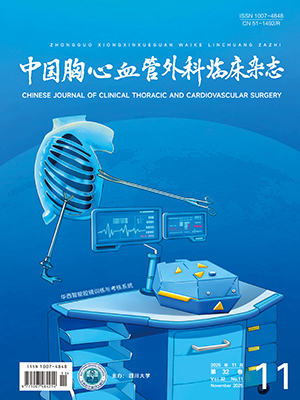Objective To investigate surgical strategies using bilateral pectoralis major muscle flaps for the treatment of sternal dehiscence after cardiac surgery. Methods From May 2005 to October 2010,21 patients with sternal dehiscence, sternal osteomyelitis and mediastinitis after cardiac surgery were admitted to Beijing An Zhen Hospital of Capital Medical University. There were 13 male patients and 8 female patients with their age of 53-72 (64.5±7.8) years. There were 19 patients after coronary artery bypass grafting (CABG) and 2 patients after heart valve replacement. The non-viable and necrotic bones were debrided and sternal wires partially or completely removed. The sternal origins of pectoralis major were released on both sides. The pectoralis major muscle flaps were tensionlessly sutured across medially over the sternal defect. Multiple suction drains were placed and removed in due time. The skin was intermittently closed. Results All the pectoralis major muscle flaps lived well after surgery,and all the patients were discharged in 2 weeks after surgery. Twenty patients were discharged with complete wound closure,and 1 patient had wound fistula and infection after removal of suction drains that was healed after another surgery to resect the wound fistula. During 6 month follow-up,sternal wound healed well in all the patients with normal thoracic appearance,and none of the patients had abnormal respiratory movement, infection recurrence or persistent infection. Conclusion Bilateral pectoralis major muscle flap technique is a positive and efficient surgical strategy for the treatment of refractory sternal dehiscence after cardiac surgery.
Citation: SUN Guanglong,CAO Xiangrong,ZHANG Jianqun.. Bilateral Pectoralis Major Muscle Flaps for the Treatment of Sternal Dehiscence after Cardiac Surgery. Chinese Journal of Clinical Thoracic and Cardiovascular Surgery, 2013, 20(2): 185-187. doi: 10.7507/1007-4848.20130056 Copy
Copyright © the editorial department of Chinese Journal of Clinical Thoracic and Cardiovascular Surgery of West China Medical Publisher. All rights reserved
-
Previous Article
Diagnosis and Treatment Experience of 84 Patients with Sacrococcygeal Pilonidal Sinus -
Next Article
《中国普外基础与临床杂志》 2012年的评估指标




